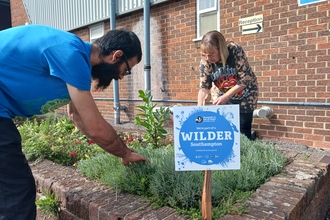
© Darin Smith
Nature Recovery Network
For many years we've known that nature reserves alone are not enough for wildlife's recovery. Too often we've seen wildlife forced into fewer and smaller pockets of wild space, surrounded on all sides by urban development or intensive agriculture.
Instead we need to create connected spaces across our landscape - in our towns and cities, on farmland, and in natural places - to give wildlife a chance to recover and adapt to pressures like climate change.
Towards a Wilder Future
We believe a Nature Recovery Network could go some way to bringing wildlife back across our town and countryside. At the heart of this is putting space for nature at the heart of our planning system - by identifying where nature is, or needs to be in our two counties and across the country.
Our most precious places must continue to receive the utmost protection - like our nature reserves and nationally internationally-recognised areas. Then, just like our road network, we need to create corridors between these wild places to help wildlife move around.
Whether it's creating wildflower corridors along our roadside verges, installing swift bricks in our homes, or including green walls and roofs in new developments - we need a network that brings wildlife into every neighbourhood.
And it's not just good for wildlife, but it's good for us - and would provide fairer access to nature and all the many health and wellbeing benefits it brings.
Every space in Britain must be used to help wildlife

Towards a Wilder Britain
Our report for the Westminster Government shows how creating a Nature Recovery Network could bring back wildlife to every neighbourhood
Creating networks in practice
We're spearheading a local partnership initiative to create an 'ecological network map' for Hampshire and the Isle of Wight.
Experts at Hampshire Biodiversity Information Centre (HBIC) on the mainland, and the Isle of Wight Council and the Area of Outstanding Natural Beauty on the Isle of Wight, have been working with us and Natural England to map out a nature recovery network area for our two counties.
Together we've identified and confirmed the absolute no-go areas for development - places like our Wildlife Trust nature reserves and the internationally protected areas of our coastline and rivers for example. However with this network approach, we can go a step further and find the best opportunities to invest resources in to create the greatest benefits for wildlife.

Local ecological map for Hampshire and the Isle of Wight
What's most important about this ecological network map is that it reveals the bigger picture. It's here that we can see the cumulative impact of individual planning and land use decisions, at a scale larger than our localised planning system allows.
The map can be used by councils, planners and the public alike to make sure that wildlife does not continue to suffer piecemeal fragmentation. Instead, planning and development could play its part in reversing declines of species by securing net gains for wildlife in the right places.
Using nature recovery networks in the Lower Test
Lower Test nature reserve is one of a handful of large unimproved grazing marshes surviving along the Solent coast. Here we manage one of the few remaining examples of a dynamic coastal estuary where salt and freshwater meet.
It's location between river and coast means it is vital to ensure that there are connected spaces for species to move around and expand into. Sea level rise is already causing this amazing transition of habitats to move inland. While this is causing an increase in saltmarsh and more saline-tolerant species, it is gradually reducing the extent of freshwater grazing marsh and the wildlife it supporters, which need space to shift inland too.
With the estuary and floodplain already constrained by housing, industry and roads, it is now more important to ensure that wildlife has space to expand.

If we are able to enhance the areas identified within the opportunity areas and improve the wider countryside around it, we will strengthen the ability of the special saltmarsh and floodplain flora and fauna to adapt to change.
The next steps
To create a wilder Britain, we need some key things in place - the laws, the tools and the people to do it,
Lower Test by Mark Heighes
1. Nature recovery maps
As we've seen locally, ecological network maps are essential to understanding where a strategy for wildlife is needed on land and on our coastlines. We want local councils across the country to co-ordinate and publish these maps. They would focus and co-ordinate effective action, funding and regulation.
© Lucy Temple
2. The people to make it happen
People and organisations from all corners of society will need to be called upon make space for nature. This includes land managers (like farmers and commoners), developers and investors, public bodies and regulators. All of us have a role to play.
More on our campaign for a Wilder Future

Let's create a Wilder Future
We’ve reached a point where our natural world is in critical condition and needs our help to put it into recovery.It’s not too late to bring our wildlife back, but we must act now.
Join our campaign for a #WilderFuture and take simple actions for nature’s recovery.

Empowering communities for a wilder future: National Lottery funding boosts Team Wilder
As the National Lottery marks its 30th birthday today - a game changer in bringing positive change to communities and nature - Hampshire…

Wilder Little Duxmore Open Day
Come and join Hampshire and Isle of Wight Wildlife Trust from 10am to 4pm on Sunday 30th June 2024 at Wilder Little Duxmore.
…

Wildlife Gardening
When we moved into our semi-detached 1990s-built house in 2019, the 6 by 11 metre back garden was pretty typical of a modern low-…
